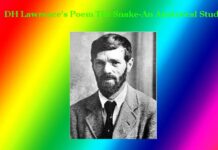Shakespeare | Sonnet 153 | An Analytical Study
Shakespeare | Sonnet 153 | An Analytical Study
Shakespeare | Sonnet 153 | An Analytical Study
Like other sonnets of Shakespeare, this ‘Sonnet No. 153’ also deals with the theme of love through which the poet expresses his deeper love to his mistress; who is called ‘Dark lady’. The sonnet is highly imaginative and his sense of love for his mistress is expressed through the imagery of Cupid, the god of love in Greek mythology. The imagery is full of conceits that strike our sense of wonder and thus surprise us.
The poet begins this sonnet with the imagery of Cupid and fantastically says that once the god of love, Cupid, was laying in sleep keeping aside the love ‘brand’ that means the weapon by which Cupid rouses the sense of love in humans. At that time a maiden of Diana, the goddess of hunting and chastity took the opportunity to extinguish the fire of the brand so that cupid could not use it to set the human heart with the passion of love. Taking this advantage, she very quickly picked the brand up and steeped it into a nearby spring of cold water. But the water of that spring itself got heated forever. Hence the spring acquired the power to heal the strange maladies of the people. When Cupid lost his love brand then he lit his brand afresh from the fire of the poet’s mistress eyes. To test the effectiveness of the fire taken up anew from the poet’s mistress, Cupid touched the poet’s breast with his new brand. Then the poet being touched became lovesick as the passion of love for his mistress roused in the poet’s heart. So to have a cure for his passion the poet dipped into the spring. But the poet found no cure because the real cure for the poet’s passion for love lay in his mistress’s eyes from whom Cupid had his brand new-fired.
The love expressed in this sonnet is no doubt, passionate, and un-feigning but the imagery through which the poet expresses his passion is very striking, charming sensuous and far-fetched. This sonnet shows how imaginative a piece of poetry may be!
The language of this sonnet is typically Shakespearean like his other sonnets where there are some phrases not easily understood by the common readers as there is the reference not only to Cupid but also to Diana and her maiden followers.
The charm of the sonnet lies not in the theme but in the imagery through which the poet brings his theme into reality. 0 0 0
Shakespeare | Sonnet 153 | An Analytical Study
Read More: W. Wordsworth’s Poem ‘To the Skylark’: An Analytical Study
N. B. This article entitled ‘Shakespeare | Sonnet 153 | An Analytical Study’ originally belongs to the book ‘World Poetry Criticism‘ by Menonim Menonimus. Shakespeare | Sonnet 153 | An Analytical Study
Books of Literary Criticism by M. Menonimus:
- World Short Story Criticism
- World Poetry Criticism
- World Drama Criticism
- World Novel Criticism
- World Essay Criticism
- Indian English Poetry Criticism
- Indian English Poets and Poetry Chief Features
- Emily Dickinson’s Poetry-A Thematic Study
- Walt Whitman’s Poetry-A Thematic Study
- Critical Essays on English Poetry
- Tawfiq al-Hakim’s Novel: Return of the Spirit-An Analytical Study
- Tawfiq al-Hakim’s Novel: ‘Yawmiyyat Naib Fil Arayaf’-An Analytical Study
- Analytical Studies of Some Arabic Short Stories
- A Brief History of Arabic Literature: Pre-Islamic Period …
Related Searches:
- Sonnet 153 by William Shakespeare
- Shakespeare Sonnets: Sonnet 153











